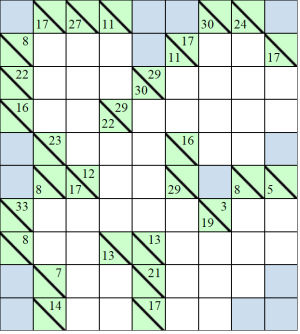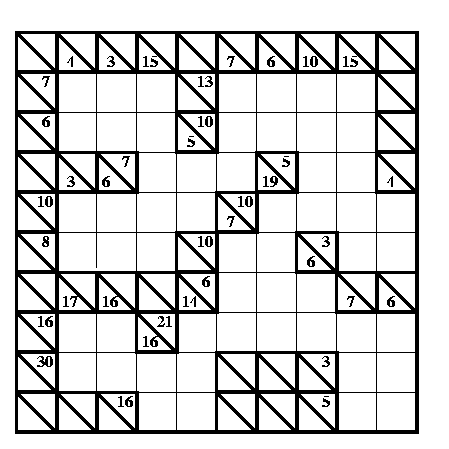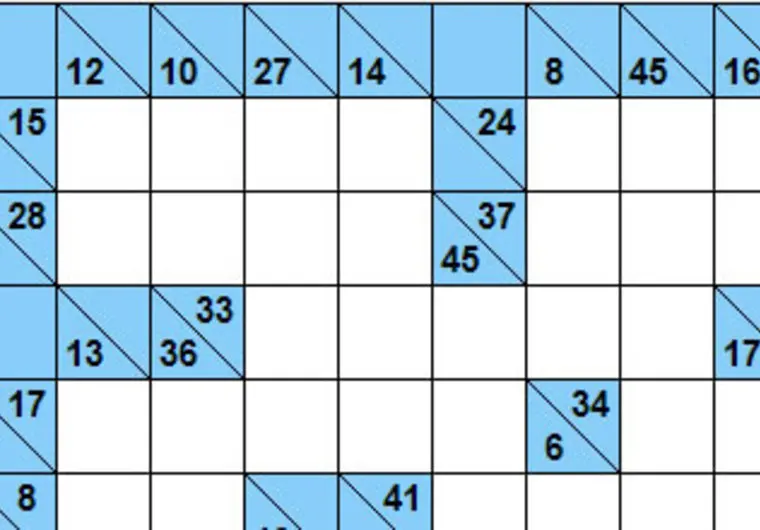What is kakuro?
It’s called Cross Sums in the USA, Kakuro in the UK, and Kakro in Japan. What is it? A new fun, entertaining and highly addictive puzzle game that is the mathematical equivalent of crosswords. In Japan, Kakro aka Kakuro popularity is immense, second only to Sudoku among Nikoli ‘s famed logic-puzzle offerings.
The Kakuro Puzzles craze came to this side of the world when The Guardian in Britain began printing the puzzle under the name Kakuro in September 2005; since then many other British papers have followed suit and now also print daily Kakuro Puzzles, and the craze is growing.

Kakuro History



The first Kakuro puzzles where called Cross Sums and were published in 1966 by Dell Magazines ( they introduced Sudoku puzzles to the world a decade later). Since then Kakuro aka Cross-Sums have been a regular feature in Math & Logic publications in the US. Cross-Sums also appears in Kappa’s Game magazine.
Kakuro puzzles aka Cross-Sums made it to Japan only in 1980, where it was imported by Maki Kaji, president of Nikoli puzzles, who named them Kasan Kurosu – a combination of the Japanese word for “addition” and the Japanese pronunciation of the English word “cross.”
6 years after it release Nikoli renamed Kasan Kurosu as Kakro, and released the first Kakro/Kakuro booklet. Since then 22 Kakuro/Kakro booklets followed and static’s show that over one million Kakuro booklets have been sold.
Kakro/Kakuro Puzzles appear in 100 Japanese magazines and newspapers today, and the Kakuro puzzles craze is in second place, right after Sudoku. According to Nikoli, Kakuro/Kakro was the top ranking puzzle till 1992 and only then was the Kakuro Puzzle over taken by Sudoku.
As with Sudoku, the market craze started only after the puzzle was exported back to the West from Japan.
The Kakuro Puzzles craze started, when the Guardian and The Daily Mail, in response to the Sudoku craze, introduced daily Kakro puzzles as Kakuro Puzzles in the UK.
Just like Sudoku, Kakuro puzzles are spreading. Kakuro puzzles can now be found in all main stream book and magazines publishing houses. Kakuro puzzle books are starting to be wide spread too, as more Kakuro titles are being released. Publishers are assuming that with the Sudoku craze still going strong, there is going to be more then enough interest in Kakuro/Cross-Sums.
Kakurolive was the first site to offer thousands of free online Kakuro puzzles. Kakurolive’s puzzles can be found in many books and magazines since it’s puzzles are unique and the Kakuro algorithm we built provide only one unique solution to each Kakuro puzzle that can be reached logically. Read more about Kakuro History here…
How to Play Kakuro
The aim is to place numbers between 1 and 9 in blocks of between two and nine empty cells running horizontally and vertically inside a larger grid. The sum of each block should match the target number, or clue, which appears inside blacked out cells, divided into two by diagonal lines, at the top (for vertical problems) or to the left (for horizontal ones) of each empty block.
No number may be used more than once in each block, so if the target number is 4, and there are two empty cells, the two numbers required are 1 and 3, not 2 and 2. You can check out online kakuro guide which will show you how to solve kakuro step-by-step. If you’re really into Kakuro, you should also memorize the kakuro block list.
Do you rather Kakuro or Sudoku?
Kakuro and Sudoku has been compared in many ways, Sudoku on the one hand is very easy to understand and popular but on the other hand all the puzzles look alike.
Kakuro is special beacuse all the puzzles have different shapes and it makes the gameplay more special, you should examine how the more difficult puzzles are larger in shape and the easier puzzles are usually smaller.
In my opinion Kakuro is much more challenging than Sudoku, but that’s of-course only me…
Have fun playing Kakuro on our Kakuro website.
We also recommend to play Pacman, play Sudoku, fun games, mahjong, Jigsaw puzzles, and Play Tetris.